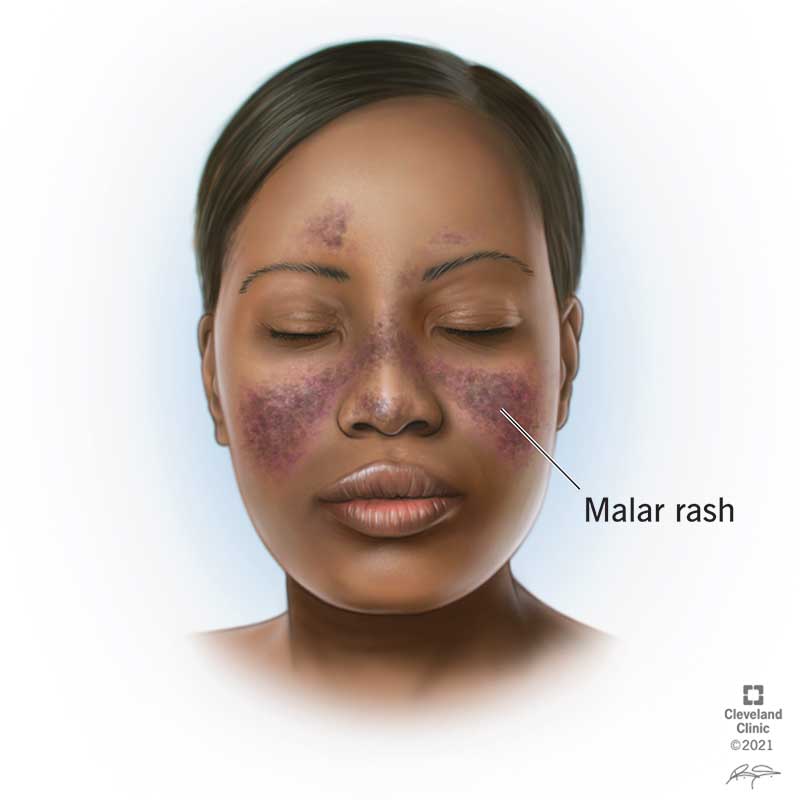Lupus causes various rashes on your face and body. A butterfly (malar) rash is a common sign. Rashes look and feel different based on the type of lupus that causes them. Some rashes trigger or get worse with light exposure or temperature changes. A healthcare provider can help you manage this symptom.
Advertisement
Cleveland Clinic is a non-profit academic medical center. Advertising on our site helps support our mission. We do not endorse non-Cleveland Clinic products or services. Policy

Skin rashes are a common sign of lupus. A lupus rash is a patch of inflamed, itchy, bumpy and discolored skin. These rashes can happen anywhere on your body. Some of the most common locations on your skin include:
Advertisement
Cleveland Clinic is a non-profit academic medical center. Advertising on our site helps support our mission. We do not endorse non-Cleveland Clinic products or services. Policy
A common lupus rash is a butterfly-shaped facial rash, known as a malar rash. This rash reaches across your nose, from cheek to cheek. There are other kinds of lupus rashes that vary based on the type of lupus you have.
You can have lupus with or without the rash. But lupus rashes tend to come and go or flare up unexpectedly. Most lupus rashes develop on sun-exposed areas of your skin. Your skin may be sensitive to light or the sun’s ultraviolet (UV) rays, which may trigger the rash or make it worse.
A healthcare provider can help you manage this symptom and its underlying cause.
There are different types of rashes based on the type of lupus that causes them. Cutaneous lupus, or skin lupus, causes chronic inflammation in your skin. Different subtypes of cutaneous lupus cause different rash symptoms.
Discoid lupus erythematosus (DLE), or chronic cutaneous lupus, is the most common form of cutaneous lupus. A discoid lupus rash typically appears on your face and scalp, but it can also affect any part of your body. Discoid lesions on your scalp may cause temporary or permanent hair loss.
A discoid lupus rash typically:
Advertisement
Chronic discoid lupus rashes or sores may put you at risk for skin cancer. Discoid sores on your lips or inside of your mouth may develop a type of skin cancer called squamous cell carcinoma.
Subacute cutaneous lupus erythematosus (SCLE) rashes tend to develop on parts of your body that get a lot of sun, such as your arms, shoulders, chest and neck.
The features of an SCLE rash include:
Acute cutaneous lupus erythematosus (ACLE) rashes happen when you have a flare-up of lupus symptoms. This means that the disease is active when you experience the rash. The rash usually occurs on your face, arms, legs or other parts of your body.
A butterfly rash (malar rash) may happen with ACLE. These rashes may cause a patch of skin with:
Rarely, ACLE also causes:
Other types of cutaneous lupus rashes may include:
There are many things within your environment that can cause a lupus rash to flare up (happen). One of the most common triggers is light exposure from the sun or artificial light sources. Lupus is an autoimmune condition, and your immune cells may react to light. These cells release chemicals to cause inflammation, which is what you see when a rash occurs on your skin.
Next to light exposure, other common lupus rash triggers include:
Advertisement
Your healthcare provider can help you determine what causes this symptom to flare up, as triggers are different for everybody.
Your healthcare provider may offer different medications to treat rash symptoms and help them go away. There are different treatment options depending on the type of lupus rash you have, including:
Your provider will help you choose the best treatment option for your body’s needs.
Lupus rashes can last for days to weeks. Some types of rashes, like discoid lupus rashes, may last for months to years in some cases. Some rash complications may be permanent, like scarring, although they may fade over time or with treatments.
A healthcare provider can help you manage a lupus rash to help it go away sooner.
You should call your provider if you experience lupus rashes that:
You may want to ask your provider:
Advertisement
Learning about what causes and triggers lupus rashes on your skin and taking steps to avoid those triggers can help prevent some lupus rashes. But not all lupus rashes are preventable.
For example, if you have photosensitive skin (light sensitivity), you can take these steps to protect yourself from sun damage and light exposure:
Lupus is a challenging condition to manage. Skin symptoms may be one of the most frustrating and stressful to experience. They’re highly visible and can affect how you feel, both physically and emotionally. But you don’t have to just live with this symptom. A healthcare provider or a dermatologist can help you treat it when it flares up. Your provider can also help you determine what’s triggering this symptom. They’ll offer solutions so you can avoid triggers to help reduce your risk of having repeat rashes in the future.
Advertisement
Knowing your body’s immune system is battling itself can be stressful. Cleveland Clinic’s lupus experts are here to treat and manage your disease for the long haul.

Last reviewed on 03/19/2025.
Learn more about the Health Library and our editorial process.